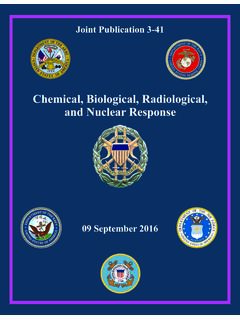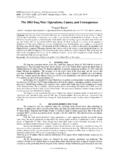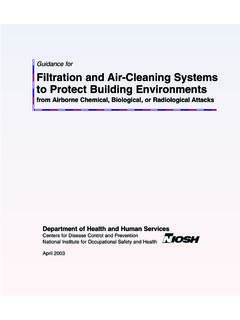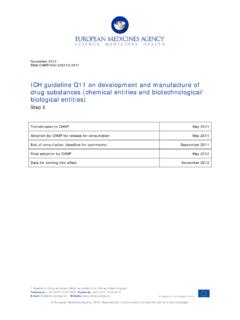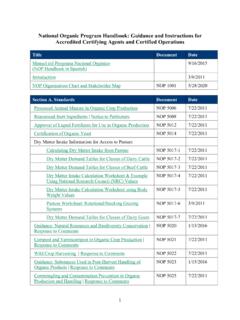Transcription of Biological Reactors (Chemostat) - MIT OpenCourseWare
1 chemical and Biological Reaction Engineering, Spring 2007 Prof. K. Dane Wittrup Lecture 13: Biological Reactors - Chemostats This lecture covers: theory of the chemostat , fed batch or semi-continuous fermentoroperations Biological Reactors ( chemostat ) Concentration/Combustion constant Biological CSTR [S]0 V F F [S], x Figure 1. Diagram of a chemostat . F = Volumetric flow rate biomassx= volume [S]0 = Concentration of growth limiting substrate. (for growing cells) At steady-state, biomass balance In Out + Prod = Acc Sterile feed: In=0 Steady state: Acc=0 +Fx rV0 at steady-state x=Cell growth kinetics rxx= +Fx xV0= Solve F = VD=Dilution rateF1 = V =DBiological Mechanical Cite as: K. Dane Wittrup, course materials for chemical and Biological Reaction Engineering, Spring 2007. MIT OpenCourseWare ( ), Massachusetts Institute of Technology. Downloaded on [DD Month YYYY]. When at steady-state, can control cell mass. Allows precisely reproducible cell states.
2 Not easy to run at steady-state. Material balance on [S] (sugar concentration) In Out + Prod = Acc 0 at steady-state 1FS[]0 FS[] xV=0 Yxs Yield coefficient mass biomass created mass substrate consumed Divide by V xDS([ ]0 =[S]) change in sugarYxconcentrations At steady-state =D x= YSx([ ]0[S]) s What is the value of [S]? What more information do we need? =f([S]) must choose a growth model to connect and [S] Monod growth model: max[]S = at steady-state KSs+[] Dmax[]S= KSs+[] KD[]S=s substitute in x equation max D chemical and Biological Reaction Engineering, Spring 2007 Lecture 13 Prof. K. Dane Wittrup Page 2 of 6 Cite as: K. Dane Wittrup, course materials for chemical and Biological Reaction Engineering, Spring 2007. MIT OpenCourseWare ( ), Massachusetts Institute of Technology. Downloaded on [DD Month YYYY]. KDxY= x []Ss 0s max D Specifying , maxKs, Yx, D, []S, can predict 0x, [S].
3 S x<0 is non-physical but formally in solution D can go to 0. If you turn knobs incorrectly: if D is too high, the cells cannot maxgrow fast enough to reach steady-state. Washout will occur. so use x=0 to find D max Dmax[]S0max= KSs+[]0 For DD> washout , no steady-state. max ,x S massvolume D maxD S x washout For real systems KS. Most cell growth systems reach maximum at fairly low s<<[]0concentrations; hence x is flat, then drops off sharply. biomass is the product, is there a best operating condition? hat should we consider? chemical and Biological Reaction Engineering, Spring 2007 Lecture 13 Prof. K. Dane Wittrup Page 3 of 6 Cite as: K. Dane Wittrup, course materials for chemical and Biological Reaction Engineering, Spring 2007. MIT OpenCourseWare ( ), Massachusetts Institute of Technology. Downloaded on [DD Month YYYY]. Figure 2. Biomass/volume versus dilution rate. Beyond the maximum dilution rate, washout occurs. If W dx optimize x with respect to D?
4 D=0 (no, because this would be batch reactor) dD Define productivity as ()()biomass=xD reactor volume time dx()D=0 for optimum. (is a maximum) dDx D xD D optimumD Figure 3. Left: Biomass/volume versus dilution rate. Right: Productivity versus dilution rate. KDs optimum= max 1 KSs+ []0 KSs<<[] 0 Doptimum max Dmax Close to washout conditions. Operability would be difficult. We would not want to run too close to washout conditions. Fed-batch fermentor (microbes or mammalian cells) -used to achieve very high cell densities ( hundreds of grams cell dry weight ( )/liter) If you want chemical and Biological Reaction Engineering, Spring 2007 Lecture 13 Prof. K. Dane Wittrup Page 4 of 6 Cite as: K. Dane Wittrup, course materials for chemical and Biological Reaction Engineering, Spring 2007. MIT OpenCourseWare ( ), Massachusetts Institute of Technology. Downloaded on [DD Month YYYY]. 100gxfinal= L 200If 0gwtY , [S]= 20% Toxic, sugar content cells will die xsLvolume Why do we n ot feed all at once?
5 Cells will die. Calculate medium feed rate in order to hold constant. [S]F0 x(t) S(t), very small Figure 4. Diagram of a fed-batch fermentor. If is constant, chemical and Biological Reaction Engineering, Spring 2007 Lecture 13 Prof. K. Dane Wittrup Page 5 of 6 Cite as: K. Dane Wittrup, course materials for chemical and Biological Reaction Engineering, Spring 2007. MIT OpenCourseWare ( ), Massachusetts Institute of Technology. Downloaded on [DD Month YYYY]. biomass = biomasstt0e = There is a dilution term, because as we feed in fresh medium, volume will change. Volume often doubles. xVV=xe t 00 xt00Ve FeedFS[] 0=xsugar feedY s sugar consumed Assume all converted into biomass. x00VF= e t []SY0xsExponential flow rate. Typically specified as small. Dilution: dV=F dt xV(te)=+V001() t 1 []SY 0x s ()biomassxe tx==0Vx11+ 0e tYSx[]0 sxeV t=00V ogistic equation Lx t Figure 5. Graph of logistic growth.
6 If product is something cells are making: Product synthesis kinetics 1) chemical and Biological Reaction Engineering, Spring 2007 Lecture 13 Prof. K. Dane Wittrup Page 6 of 6 Cite as: K. Dane Wittrup, course materials for chemical and Biological Reaction Engineering, Spring 2007. MIT OpenCourseWare ( ), Massachusetts Institute of Technology. Downloaded on [DD Month YYYY]. 1dP= growth associated ( ethanol) xdtproductP volume2) 1dP= not growth associated ( antibiotics, proteins, antibodies) xdtPx= tdt integrate for amount of product. 0












